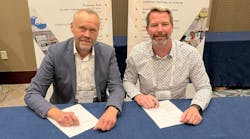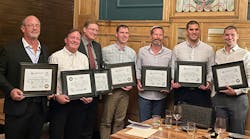The latest advancements in eddy current flaw detection can be found in the Nortec 600 from Olympus Scientific Solutions Americas Inc.
The device recently was put to an extreme test – astronauts used the device to inspect cracks on the International Space Station. As Ghislain Morais, product leader, Eddy Current Product Line, wrote in a Jan. 28 Olympus InSight Blog, “Going into space is arguably the most extreme environmental test there is.”
The rugged device has a protection rating of IP66 and a battery life of up to 10 hours. A bright, 5.7-inch VGA display produces visible eddy current signals in any lighting condition.
The Nordtec 600 is used for surface inspection, wheel inspection, bolt hole testing, conductivity and coating thickness measurements, and weld inspection.
For surface inspection, the NORTEC 600 includes all the standard features for medium-high frequency surface inspection, including impedance plane views, 10x10 grid, sweep (strip chart), multiple alarm configurations, automatic lift-off, and others. New features include fine (expanded) and web grids, and the automatic internal balance circuit (for BNC connector).
For wheel inspection, wide gain range (0 –100 dB) and state-of-the-art electronics deliver signals, without requiring a preamplifier.
For bolt hole (rotary scanner inspection), the Nortec 600 has predefined factory settings. The flaw detector’s filters are set by default to a “figure 6” signal shape, the typical shape of the rotary bolt hole application. A “figure 8” signal shape can be selected if needed. Fitter settings also can be selected automatically according to scanner speed settings.
For conductivity and non-conductive coating thickness, the Nortec 600 can measure thicknesses of up to 0.64 mm (0.025 inches) on non-ferromagnetic materials.
For weld inspection a pre-defined setup helps simplify instrument preparation and calibration.
James Bittner, an NDT applications engineer and technology specialist with Olympus, said eddy current is used to inspect metallic aircraft and, to a lesser extent, composite aircraft, as well as engine components and subcomponents.
“I think the technology has really reached a point where eddy current is going to be more the norm,” he said.
Bittner started working in the field of nondestructive testing technology about 30 years ago. About that time, eddy current testing was transitioning from analog to digital. “When that started to happen,” he said, “the applications for eddy current exploded.”
He points out that eddy current is not only used for surface but subsurface inspections. Using eddy current allows the operator to complete many of the required inspections without needing to remove paint or primer. This has saved the airlines and the aviation industry billions of dollars. “The eddy current fields generated from a probe can penetrate those coatings and look for subsurface cracking or corrosion that may be occurring right under the paint surface,” he said, adding imagine trying to remove all the paint and primer to do an inspection then repaint it again and the time that would take.
Another significant time savings, he points out, is in the inspection of thousands of fastener hoses used in the construction of aluminum aircraft. Scanners that can be used with Nortec Eddy Current Flaw Detectors have speed ranges from 600 to 3000 rpm and frequency ranges from 50 kHz to 6 MHz and offer a full range of applications.
The very first Nortec version was released in 1968. The Nortec 600 replaced the Nortec 2000 and Nortec 500 (2016). Over time, Bittner described the instrument has gotten a lot more user-friendly.
For instance, signal calibration in Freeze mode saves calibration time. An operator can initially focus on the movement of the probe. After the scan is done, the gain and angle can be adjusted while the signal is in Freeze mode.
Other new key features include:
• Full-screen option in any display mode.
• Improved filters for rotary scanner mode.
• Intuitive interface with Application Selection presets.
• All-settings configuration page.
• 10 Hz to 12 MHz frequency capacity.
• Automatic internal balancing (for BNC connector).
• Up to two real-time readings.
• Storage capacity of up to 500 files (program and data).
• Onboard file preview.
“We’re seeing a lot more data collection,” he said.
By saving data, notes relating to health monitoring can be reviewed at the next inspection.
Files can be saved with the single press of a SAVE key. Current settings (program) and signals (data) are saved in the instrument’s memory in a single file. Nortec PC software allows exchange of files between the Nortec 600 and a PC connected by a USB cable.
Nortec PC also allows remote control of the Nortec 600.
The NORTEC 600 is available in four instrument models to meet the widest range of inspection needs. From the basic model upward, each unit unlocks more features.
• The N600 is the basic model, meeting the critical information needs of most inspectors in the field.
• The N600C measures conductivity and non-conductive coating thickness.
• The N600S supports rotary scanner operation (and also measures conductivity and coating thickness). The device is compatible with scanners from Olympus and other major suppliers.
• The N600D is the most advanced. It has the capabilities listed for the N600S and offers frequency adjustment (dual frequency mode) and mixing.
Which model works best depends on the requirements of the application. For general aviation, most are doing basic surface and wheel inspection, scanner capability is not always needed.
For those who already have eddy current technology and are looking to buy a new instrument should look at whether or not probes and cables are compatible with their existing technology.





